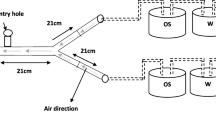Abstract
Previous work had shown propiconazole applied to wool gave a protective effect against the keratinophagous insect larvae of the Australian carpet beetle Anthrenocerus australis. To elucidate the mode of action of propiconazole on Anthrenocerus australis, repellency trials were carried out using untreated control and propiconazole-treated wool. A reversible choice experiment using Petri dishes, and an irreversible olfactometer choice experiment were carried out. Treated surface repellency trials were also carried out. No repellency effect was detected with any of these experiments. Direct contact experiments were carried out by application of propiconazole solutions directly to Anthrenocerus australis larvae and by feeding larvae propiconazole-treated wool. No short or long-term toxic effects were detected, and subsequent feeding on untreated wool was not reduced. These results suggest an anti-feeding and/or gut-specific mode of action of propiconazole on Anthrenocerus australis that is likely to be different to that of the commonly used wool insecticides. This provides an opportunity to research a new approach to the control of this wool pest.



Similar content being viewed by others
References
Allanach D, Shaw T (1989) Mothproofing and the environment. In: Proceedings of TIFCON’89 – Carpets what’s afoot? Conference of the Textile Institute’s Floorcoverings Group, Paper 4, Blackpool, United Kingdom
Barton J (2000) It’s a bugs life – or is it? Intl Dyer 185(9):14–16
Campo ML, Miles CI (2003) Chemosensory tuning to a host recognition cue in the facultative specialist larvae of the moth Manduca sexta. J Exp Biol 206:3979–3990
Christeller JT, Markwick NP, Burgess EPJ (1994) Midgut proteinase activities of three keratinolytic larvae, Hofmannophila pseudospretella, Tineola bisselliella, and Anthrenocerus australis and the effect of proteinase inhibitors on proteolysis. Arch Insect Biochem Physiol 25(2):159–173
Diaz-Montano J, Trumble JT (2013) Behavioral responses of the potato psyllid (Hemiptera: Triozidae) to volatiles from dimethyl disulphide and plant essential oils. J Insect Behav 26(3):336–351
Ingham PE, McNeil SJ, Sunderland MR (2012) Functional finishes for wool – Eco considerations. Adv Mater Res 441:33–43
Lamb KP (1952) Note on the survival without food of Australian carpet beetle larvae (Anthrenocerus australis (Hope)) (Coleoptera: Dermestidae). N Z J Sci Technol A 34(1):67–68
McDonald LL, Guy RH, Speirs RO (1970) Preliminary evaluation of new candidate materials as toxicants, repellents and attractants against stored product insects. Marketing Research Report Number 882. Washington Agricultural Research Service, US Dep Agric p. 8
Mill W (2007) Beating moths the clean way. Wool Rec 166(3758):30
Nenaah GE (2014) Chemical composition, insecticidal and repellence activities of essential oils of three Achillea species against the Khapra beetle (Coleoptera: Dermestidae). J Pest Sci 87:273–283
Osipitan AA, Owoseni JA, Odeyemi IS, Somade AA (2010) Assessment of extracts from some tropical plants in the management of termite (Termitidae: Isoptera) in Ogun state, Nigeria. Arch Phytopathol PFL 43(10):962–971
Raffa KF, Havill NP, Nordheim EV (2002) How many choices can your test animal compare effectively? Evaluating critical assumption of behavioral preference tests. Oecologia 133(3):422–429
Schoonhoven LM, van Loon JJA (2002) An inventory of taste in caterpillars: each species its own key. Acta Zool Acad Sci Hung 48(Suppl 1):215–263
Stratton GW, Corke CT (1981) Interaction of permethrin with Daphnia magna in the presence and absence of particulate material. Environ Pollut 24(2):135–144
Sunderland MR, Cruickshank RH, Leighs SJ (2014) The efficacy of antifungal azole and antiprotozoal compounds in protection of wool from keratin-digesting insect larvae. Tex Res J 84(9):924–931
Svoboda JA (1994) Steroid metabolism as a target for insect control. Biochem Soc Trans 22(3):635–641
Tomlin CDS (1997) A world compendium: the pesticide manual, 11th edn. Farnham, British Crop Protection Council, p. 944
United States Environmental Protection Agency (2006) Reregistration eligibility decision (RED) for propiconazole. http://epa.gov/oppsrrd1/REDs/propiconazole_red.pdf. Accessed 18 June 2014
Wools of New Zealand Test Method 25 (1996) Biological assay of insect resistance
Acknowledgments
The authors are thankful to Dr Chikako van Koten for her help with statistical analyses. This work was supported by the Wool Research Organisation of New Zealand Inc., and the New Zealand Wool Industry Charitable Trust.
Author information
Authors and Affiliations
Corresponding author
Ethics declarations
Conflict of Interest
The authors declare that they have no conflict of interest.
Rights and permissions
About this article
Cite this article
Sunderland, M.R., Cruickshank, R.H. Investigations into the Toxic and Repellent Effects of Propiconazole on the Wool-Digesting Carpet Beetle Larvae Anthrenocerus australis (Coleoptera: Dermestidae). J Insect Behav 29, 57–68 (2016). https://doi.org/10.1007/s10905-015-9542-0
Revised:
Accepted:
Published:
Issue Date:
DOI: https://doi.org/10.1007/s10905-015-9542-0



